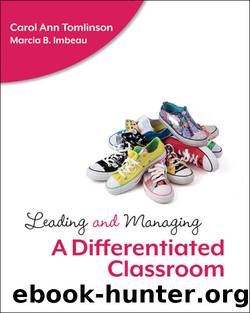Leading and Managing a Differentiated Classroom by Carol Ann Tomlinson

Author:Carol Ann Tomlinson [Tomlinson, Carol Ann]
Language: eng
Format: epub
Tags: EDUCATION
ISBN: 9781416610748
Publisher: ASCD
Published: 2010-11-01T05:00:00+00:00
Developing community
Leading students to form a positive sense of community, of course, is tightly linked to getting to know students. As a teacher shows interest in knowing individual students and treats them with respect, others notice. It becomes evident that, in that teacher's classroom, people matter, and there are opportunities for all students to learn about one another. The class is also engaged in a conversation about creating an environment in which each person is seen as valuable and in which the growth of each person is of ultimate importance. As the conversation unfolds, the teacher continues to bring students back to the original reason for creating a classroom that is responsive to each studentâeach student matters. Often implicit (but occasionally explicit) in this conversation is the idea that "This is who we are. This is what we do." As a result, the group becomes more defined, and students eventually develop a better understanding of one another, see their ideas enacted, and work together with increased effectiveness. Ultimately, a community forms.
As is the case with getting to know students, there are many ways to contribute to the formation of a classroom community in which individuals share common interests and goals. Consider the following classroom examples:
A high school English teacher came to the honest but difficult conclusion that by the time students reached her class, few had a burning desire to read more poems, complete more grammar exercises, or write additional formulaic essays. She understood that she would have to create a classroom in which students felt connected in a way that made her content seem important to them. She began by creating a classroom space in which students could carry on a conversation. She told students small stories from her life, and she invited them to tell their own. "I love a good story," she often said. "I'll even delay a test for five minutes if someone has a good story to tell ⦠but it better be good!" In time, she began to tell stories from her life that had more meaning. By then, her students were listening to one another with positive regard, and they trusted that they could share meaningful stories from their own lives. She helped them recognize how their stories were like those of the authors they read. She also helped them believe that their stories were worth preserving in written form. Throughout the year, she purposefully and simultaneously led students to bond around storytelling and related the material she taught to the people she taught. The class was life-shaping for her students; many of them developed into devoted readers and writers.
A primary teacher reserved a classroom wall to post 10 calendar pagesâone for each month the students were in school. The pages were large and offered ample room to write. On the first day of school, she told her students that they would be writing a class history as the year went on. "When something important happens," she said, "we'll put it on our calendar with words and drawings and pictures.
Download
This site does not store any files on its server. We only index and link to content provided by other sites. Please contact the content providers to delete copyright contents if any and email us, we'll remove relevant links or contents immediately.
The Art of Coaching Workbook by Elena Aguilar(50957)
Trainspotting by Irvine Welsh(21515)
Twilight of the Idols With the Antichrist and Ecce Homo by Friedrich Nietzsche(18501)
Fangirl by Rainbow Rowell(9093)
Periodization Training for Sports by Tudor Bompa(8166)
Change Your Questions, Change Your Life by Marilee Adams(7630)
This Is How You Lose Her by Junot Diaz(6776)
Asking the Right Questions: A Guide to Critical Thinking by M. Neil Browne & Stuart M. Keeley(5627)
Grit by Angela Duckworth(5511)
Red Sparrow by Jason Matthews(5389)
Paper Towns by Green John(5086)
Room 212 by Kate Stewart(5034)
Ken Follett - World without end by Ken Follett(4641)
Housekeeping by Marilynne Robinson(4328)
The Sports Rules Book by Human Kinetics(4288)
Double Down (Diary of a Wimpy Kid Book 11) by Jeff Kinney(4203)
Papillon (English) by Henri Charrière(4193)
The Motorcycle Diaries by Ernesto Che Guevara(4008)
Exercise Technique Manual for Resistance Training by National Strength & Conditioning Association(3953)
